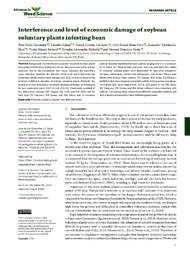Interference and level of economic damage of soybean voluntary plants infesting bean.
Interference and level of economic damage of soybean voluntary plants infesting bean.
Author(s): GIACOMINI, J. P.; GALON, L.; CAVALETTI, D. C.; HENZ NETO, O. D.; SILVA, A. F. da; SENHORI, V. M.; HABOSKI, D. A.; PERIN, G. F.
Summary: Background: The interference caused by volunteer soybean plants from grains lost before or during harvest can cause economic losses to bean producers due to the competition they cause, especially for succeeding crops. Objective: Therefore, the objective of this work was to determine the competitive ability and economic damage level (EDL) of bean cultivars in the presence of different densities of soybean volunteer plants. Methods: The experiments were installed in completely randomized design, and replicated for two consecutive years, 2020/21 and 2021/22. Treatments consisted of the carioca bean cultivars BRS Tangará, IAC 1850, and BRS Estilo and the black type IPR Uirapuru, IPR Urutau, and BRS Esteio, and 12 volunteer soybean densities established for each cultivar, ranging from 0 to a maximum of 66 plants m-2. Plant density, soil cover, leaf area, and shoot dry matter of volunteer soybean plants were determined 40 days after emergence. For bean, productivity, control cost, selling price, and control efficacy were determined. Results: Bean cultivars IPR Tangará, BRS Estilo, IPR Uirapuru and BRS Esteio showed greater competitive ability in the presence of soybean. The highest EDL values ranged from 1.00 to 2.89 plants m-2 for BRS Estilo, IPR Uirapuru, IPR Urutau and BRS Esteio cultivars when competing with soybean. Conclusions: Bean cultivars have different competitive abilities, and EDL is directly influenced by these different genetic traits.
Publication year: 2024
Types of publication: Journal article
Unit: Embrapa Maize & Sorghum
Keywords: Feijão, Glycine Max, Perda Durante a Colheita, Phaseolus Vulgaris, Soja, Volunteer plants
Observation
Some of Embrapa's publications are published as ePub files. To read them, use or download one of the following free software options to your computer or mobile device. Android: Google Play Books; IOS: iBooks; Windows and Linux: Calibre.
Access other publications
Access the Agricultural Research Database (BDPA) to consult Embrapa's full library collection and records.
Visit Embrapa Bookstore to purchase books and other publications sold by Embrapa.

